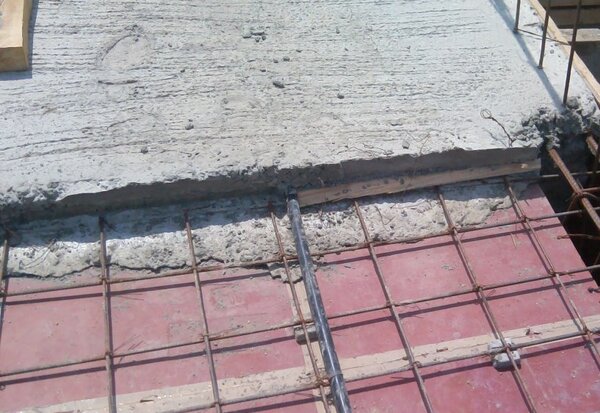Construction Joints in Concrete – Construction bonding keys
When the work is to be interrupted, horizontal and vertical construction joints and bonding keys shall be located and shall conform to the details given on the drawings. In case of water retaining structure, containment structure and other structures, water stops as specified on the drawing shall be provided.

In case of columns, beams and slabs etc, the location of the joints shall be as indicated in the drawing. Concrete in a beam shall be placed throughout, without a horizontal joint.
Before fresh concrete is placed, cement skin or any loose or porous material of partially hardened concrete shall be thoroughly removed and cut back until the solid face is exposed and surface made rough by hacking, or any other method.
RCC road construction process- Trimix flooring
Rough surface shall be thoroughly wetted for about two hours and shall be in surface dry condition before new layer of concrete is placed over it.
Sequence of Casting and Construction Joints
The sequence of concreting, locations of construction joints etc. will be as shown on the drawing.
Some factors influencing final joint locations are:
1. Embedded parts and local thickenings
2. Locations of prestressing cables or reinforcements
For containment wall, in general, the constructions joints would be located between consecutive ring cables. Where these cables are deviated to go around openings, the horizontal cables may be allowed to penetrate the horizontal construction joints as may be required.
The general lift height will be maximum 3m for containment wall. The thickened portion of the wall at raft-wall junction shall be cast in two lifts as specified in construction drawings. In general, each of the lift of the wall will be cast in single pour.
Placement interval between two subsequent or adjacent pours shall be as specified in the drawing.
The containment flat roof slab should be cast in one pour. The base raft will also be preferably cast in one pour. Appropriate concrete mix (e.g. self-compacting concrete) should be developed for this purpose.
Contractor should develop and got approved by the engineer in-charge suitable procedure and adequate planning prior to commencement of large pour in order to avoid cold joints.
Meridional joints are not permitted except for emergency stoppage of work. The concreting will start for the first pour at the crown and subsequent pours from crown downwards will be taken up for casting.
Casting in any particular pour will, however start from the lower most elevation and proceed upwards.
The treatment of the construction joints of the containment structure to render them leak tight by grouting. Re-injectable grouting hose of approved quality shall be laid along the construction joints.
The grouting material to be used and grouting operation shall be as approved by the manufacturer
Treatment on concrete Suspension of Work
Whenever work is suspended on any section for more than two hours, the horizontal edges of the concrete next to the forms on surfaces that will be exposed shall be brought to a horizontal plane perpendicular to the plane of the forms and treated, so that the finished work will show smooth straight lines.
Construction Joint Treatment
Green cutting shall be made to treat the entire construction joint. Suitable surface retarder shall be used to retard the setting of concrete to a depth of 5 to 7 mm from the exposed surface that is going to receive subsequent concrete.
Green cutting shall be done by using air water jet at a suitable pressure to remove laitance from concrete surface at construction joint, exposing aggregate matrix, and shall be done only after the concrete is in final set condition.
The water from the air water jet, used for green cutting of the concrete surface, shall be properly drained so as not to harm the quality of the concrete already placed. It shall also be ensured that this water does not get stagnated on the surface of concrete, depositing washed cement particles.
As a pre-qualification, field Material of Construction-ups shall be conducted to check the adequacy of the material and method to be deployed on the job, before adopting in the field. In case of change in material source / type or methodology of green cutting, pre-qualification shall be redone.
In areas where green cutting is not feasible, spraying of retarders followed by wire brushing immediately after final setting shall be adopted.
Concrete Surface Retarders agent
surface retarding (set retarding) agent shall be used for preparation of construction joint by green cutting of concrete. It shall be solvent free poly-hydroxyl compound and shall have a distinctive colour, which could be easily identifiable on its application over concrete.
It shall be suitable for removing the cement-sand matrix between 5 to 7 mm depth after final setting time, when air water jet with a pressure of around 7 Kg/cm 2 from distance of approx. 500 mm is used. It may be noted that there is no specific testing for qualification of surface retarders other than its meeting desired performance specified above.
Wash Water for Concrete Surfaces
Wash water shall be removed in a manner to prevent running down and staining of concrete surfaces, exposed on completion of the job. Should unsightly wash-water streaks develop on the exposed surface, the same shall be removed to get a uniform colour and texture.
Filling of construction joints and shrinkage Concrete cracks wider than 0.05mm
All construction joints including the shrinkage cracks developed during the construction period (The shrinkage cracks should be allowed to get developed for period of not less than 3 months the date of casting. The engineer should refer the procedure laid down at SEAONC method should be prepared, cleaned and filled with epoxy filler.
We request our readers to give their valuable suggestions on our today’s article Construction Joints in Concrete – Construction bonding keys and like our page to get the latest update about – Civil Engineering
Leave a Reply